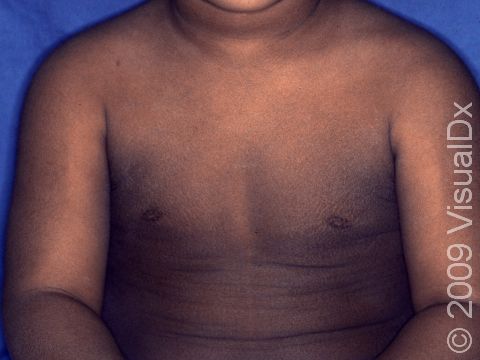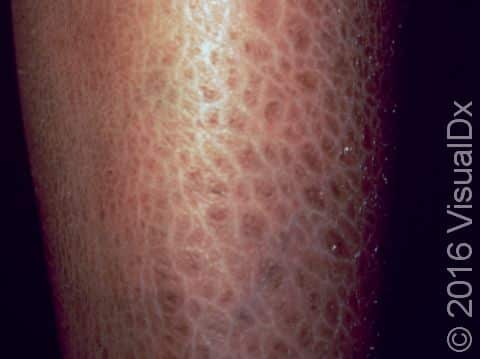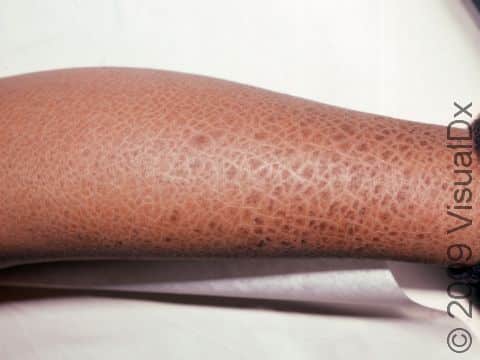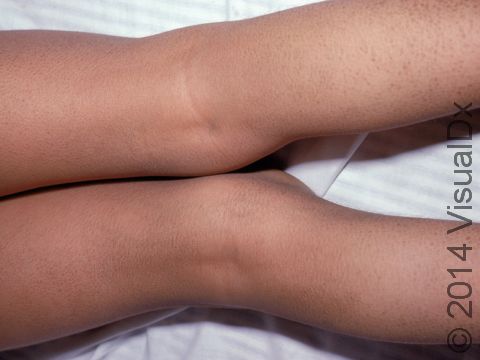Scaly Skin (Ichthyosis Vulgaris)
Ichthyosis vulgaris is a skin condition resulting in dry, scaly skin, especially on the arms and legs. Its name is derived from the Greek word meaning “fish” and refers to the fish-like, scaly appearance of the skin that occurs.
Ichthyosis vulgaris can be a trait passed on in families (hereditary ichthyosis vulgaris), or it may develop later in life (acquired ichthyosis vulgaris). The hereditary type, also called congenital ichthyosis vulgaris, first appears in early childhood and accounts for more than 95% of cases of ichthyosis vulgaris. Hereditary ichthyosis vulgaris tends to improve after puberty. The acquired type usually develops in adulthood and results from an internal disease or the use of certain medications.
Who's At Risk?
Ichthyosis vulgaris is found in people of all races / ethnicities and sexes. Hereditary ichthyosis vulgaris is fairly common. As many as 1 in 250 children have hereditary ichthyosis vulgaris. Acquired ichthyosis vulgaris is rarer and is found almost exclusively in adults.
In hereditary ichthyosis, at least one of the affected child’s parents usually had the same dry, scaly skin as a child.
Ichthyosis vulgaris is more severe in those who live in cold, dry climates and who use harsh soaps or detergents.
Signs & Symptoms
The scales of ichthyosis vulgaris range in size from 1-10 mm. The scales may be white, gray, or brown, with darker skin colors often having darker scales and lighter skin colors having lighter scales. The affected areas are usually itchy. The legs are typically affected more than the arms. The creases on the palms of the hands and the soles of the feet are prominent and often crack during dry or cold weather. In more humid, warmer weather, the scaling tends to improve.
The most common locations for ichthyosis vulgaris include the:
- Fronts of the legs.
- Backs of the arms.
- Scalp.
- Back.
- Forehead and cheeks, especially in younger children.
Self-Care Guidelines
Ichthyosis vulgaris should improve by restoring moisture to the skin. Thick creams (eg, CeraVe Moisturizing Cream) and ointments (eg, Vaseline) are better moisturizers than lotions, and they should be applied just after your child’s bath or shower, while the skin is still moist. Moisturizer should then be applied at least one other time each day. The following over-the-counter products may be helpful:
- Preparations containing alpha-hydroxy acids such as glycolic acid or lactic acid (eg, AmLactin creams)
- Creams containing urea (eg, Pedinol Ureacin-20 cream)
- Over-the-counter cortisone cream (if the areas are itchy)
- Mild cleansers (eg, Cetaphil Gentle Skin Cleanser) instead of soaps
Any cracks in the skin should be treated immediately with a topical antibiotic ointment (eg, Neosporin) to prevent an infection.
Treatments
To treat the dry, scaly skin of ichthyosis vulgaris, the medical professional may recommend a topical cream or lotion containing prescription-strength alpha-hydroxy acid, salicylic acid, or urea.
Visit Urgency
If your child continues to have very dry, scaly skin despite twice-daily application of an over-the-counter moisturizer, talk to their medical professional about what may help relieve their symptoms.
References
Bolognia J, Schaffer JV, Cerroni L. Dermatology. 4th ed. Philadelphia, PA: Elsevier; 2018.
James WD, Elston D, Treat JR, Rosenbach MA. Andrew’s Diseases of the Skin. 13th ed. Philadelphia, PA: Elsevier; 2019.
Kang S, Amagai M, Bruckner AL, et al. Fitzpatrick’s Dermatology. 9th ed. New York, NY: McGraw-Hill Education; 2019.
Paller A, Mancini A. Paller and Mancini: Hurwitz Clinical Pediatric Dermatology. 6th ed. St. Louis, MO: Elsevier; 2022.
Last modified on June 17th, 2024 at 3:22 pm

Not sure what to look for?
Try our new Rash and Skin Condition Finder





